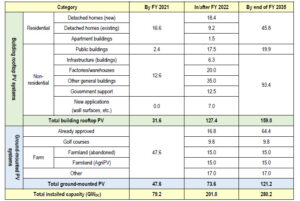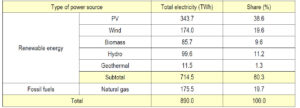Japan Solar Update: No.52 (July 3 ~ 7, 2023)
The Renewable Energy Institute released the Proposal for the 2035 Energy Mix (First Edition): Toward Decarbonizing Electricity with Renewable Energy, on April 11, 2023. In the Sixth Assessment Report, the IPCC appealed to the world to reduce CO2 emissions by 65% compared to 2019 levels by 2035 to realize the 1.5-degree target. In response to this, the Renewable Energy Institute concluded that Japan must aim to supply at least 80% of its electricity from renewable energy sources by 2035, aiming to achieve a 65% reduction.
Regarding PV power generation,power generation costs in Japan,which have been relatively high compared to international standards, are expected to decline to around 5 Yen/kWh ($ 3.58 cents/kWh) by 2030. It is likely that PV power will be increasingly chosen for the economic advantage it offers.
In the future, building rooftop PV installation will replace large-scale ground-mounted installation as the largest driver for the introduction of PV systems. The introduction of PV systems is expected to be promoted not only to new buildings but also to existing buildings, thanks to the lower cost of PV electricity compared to grid electricity, and the development of lightweight and space-saving PV modules, etc. With appropriate regulations and guidance measures,PV installed capacity will be accelerated and installation on building rooftops is estimated to increase fivefold, from 31.6 GW in FY 2021 to 159GW by the end of FY 2035.
Table 1 Installed capacity of PV systems on building rooftops by FY 2035 (GW (DC)) Category By FY 2021 In/after FY 2022 By end of FY 2025

Source: The Renewable Energy Institute (REI)
In the ground-mounted installation, solar sharing (PV system installation on farmland while continuing agricultural activities) and utilization of abandoned farmland are progressing. Installed capacity of ground-mounted PV systems could increase 2.5-fold from 47.6 GW at the end of FY 2021 to 121.2 GW by the end of FY 2035, including installations on parking lots, infrastructure-related land (roads,airports, railroads, etc.) and on water surfaces.
The total installed capacity of building rooftop systems and ground-mounted systems is expected to be 280.2 GW by the end of FY 2035 and the power generation amount is estimated to be 343.7 TWh, assuming a uniform capacity factor of 14.0%.
The total electricity demand in 2035 is estimated to be 850 TWh as a result of energy conservation efforts through a shift to a circular economy, utilization of electric heat pump equipment and electrification of the transportation sector (promotion of EVs). Adding transmission losses to this amount, the total power supply requirement will be 890 TWh.
The amount of electricity generated by renewable energy can be increased to 714.5 TWh in total, including PV power (347.3 TWh), wind power (174.0 TWh), biomass, hydroelectric and geothermal power. The remaining amount of electricity needed for supply (175.5 TWh) will be covered by natural gasfired thermal power. To maximize CO2 reductions, the use of coal-fired thermal power is not envisaged. Likewise, the use of nuclear power is not assumed because it cannot be assessed as a sustainable power source due to its inability to maintain continuous power generation after 2035 and the fact that no final disposal site for radioactive waste has yet been secure.
Table 2 Decarbonized electricity mix in 2035
Source: The Renewable Energy Institute (REI)
This decarbonized electricity mix will enable a 73.2% reduction of CO2 emissions from the power generation sector, compared to 2020 levels. Furthermore, since the amount of fossil fuels required for thermal power generation could be significantly reduced compared to the current level, fuel costs for power generation will be reduced from 5.368 trillion Yen ($ 38.4 billion) in FY 2021 to 1.159 trillion Yen ($ 8.30 billion). As 80% of the electricity would be generated by domestic renewable energy resources, the decarbonized electricity mix would contribute to improving energy selfsufficiency and strengthening energy security.
The Renewable Energy Institute proposes that the following initiatives are crucial toward the realization of a decarbonized electricity mix: 1) Prompt revision of the Strategic Energy Plan and setting the 2035 renewable electricity target to at least 80%; 2) Making the installation of PV systems in new buildings mandatory nationwide,including residential buildings; 3)Initiating the full-scale reinforcement of wide-area transmission network between Hokkaido and Honshu; 4) Early introduction of carbon pricing to attract global decarbonization investment to Japan and 5) Acceleration of corporate PPAs.
*The proposal can be downloaded for free from the following website of the Renewable Energy Institute.Proposal for the 2035 Energy Mix (First Edition)

